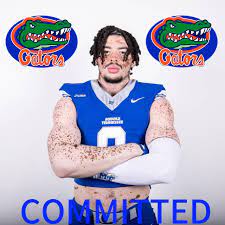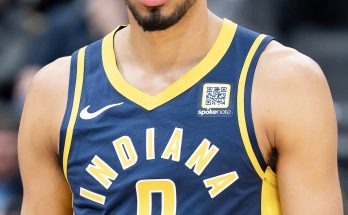In one of the most stunning moments of the college football recruiting cycle, a five-star quarterback prospect has just sent shockwaves across the nation by turning down a jaw-dropping $7.5 million NIL offer, decommitting from the Florida Gators, and ultimately flipping his commitment to the Miami Hurricanes over other elite programs including Notre Dame and Florida State. This decision has left fans, analysts, and insiders scrambling to digest what it means for the future of college football’s quarterback landscape—and the ongoing battle for recruiting supremacy among some of the sport’s most storied programs.
The quarterback at the center of this seismic move, widely regarded as one of the most talented and promising signal-callers in his class, was previously considered a near-lock for Florida. The Gators had aggressively pursued him, reportedly offering one of the largest NIL contracts ever seen in college football to secure his commitment. $7.5 million in NIL deals is an astronomical figure, underscoring just how highly Florida valued this player and the potential impact he could have on their program. Yet, in a decision that surprised nearly everyone in the college football world, the quarterback decided to forgo the money, withdraw his commitment to Florida, and pledge his future to Miami.
This development is particularly significant given the landscape of college football recruiting and NIL (Name, Image, and Likeness) deals. Since the NCAA’s NIL policy change, programs and boosters have been in fierce competition to offer top recruits lucrative endorsement deals and marketing opportunities. These offers have sometimes swayed players’ decisions, but this quarterback’s choice to reject such a massive financial package signals a possible shift in the priorities of elite prospects. Instead of choosing the biggest paycheck, this young talent has opted for a program and environment that he believes will best develop his skills and position him for long-term success.
The Miami Hurricanes, long known as a historic football powerhouse with five national championships and a rich legacy of producing elite NFL talent, have been aggressively rebuilding under their current coaching staff. Miami’s resurgence on the recruiting trail has gained momentum, and landing a player of this caliber cements their status as a serious contender for the college football elite. The program’s ability to convince this star quarterback to join them over two other prestigious programs—Notre Dame and Florida State—demonstrates not only Miami’s growing appeal but also the power of their vision and culture.
Notre Dame and Florida State, both legendary programs with deep traditions, were also in pursuit of this five-star prospect. Notre Dame, with its national brand, history of success, and unique academic-athletic blend, was considered a top contender to secure the quarterback’s commitment. Florida State, a program with a rich football heritage and a passionate fanbase, had also aggressively courted the player. The fact that Miami outmaneuvered these giants in the recruiting battle highlights how much the landscape is evolving, with newer forces on the rise and NIL influence reshaping traditional recruiting dynamics.
The quarterback’s decision also has profound implications for the Florida Gators. After spending significant resources, both financially and in recruiting efforts, the Gators will now have to regroup and recalibrate their quarterback search. This setback could alter the trajectory of Florida’s rebuilding plans and send ripples throughout the SEC, which prides itself on recruiting top-tier talent to fuel its dominance in college football.
What makes this story even more compelling is the quarterback’s publicly stated reasons for the flip. Insiders close to the player report that the decision was motivated by a combination of factors, including the coaching staff’s vision, offensive scheme fit, development opportunities, and the culture of the Miami Hurricanes program. The player reportedly emphasized that he wanted a program that not only offers a path to the NFL but also provides a supportive environment that nurtures growth both on and off the field.
This approach contrasts sharply with the narrative many expect when NIL deals come into play. In recent years, there has been a perception that top recruits prioritize financial incentives above all else, making their decisions largely transactional. However, this quarterback’s choice reveals a more nuanced reality—that while NIL deals are influential, elite athletes also deeply consider the intangibles of coaching, development, and program culture. This could signal a shift in how recruits balance money versus football development when choosing their future teams.
The impact on Miami’s fanbase has been electrifying. Social media platforms exploded with excitement and praise for the coaching staff and program leadership for pulling off such a monumental win. Fans have already begun envisioning the future with a dynamic, highly skilled quarterback leading their Hurricanes, reviving memories of Miami’s golden eras. The anticipation is palpable, as this commitment could be the cornerstone for Miami’s return to national title contention.
Recruiting analysts are already speculating about how this move will affect other top quarterback prospects nationwide. Miami’s success in landing this player despite the lure of a massive NIL offer elsewhere may encourage other prospects to consider program fit and development over immediate financial gain. This could influence the recruiting landscape for years to come, creating a more balanced approach among top recruits weighing their options.
Furthermore, this quarterback’s decommitment and flip underscore the volatility and drama inherent in college football recruiting today. With NIL deals, transfer portals, and ever-changing coaching staffs, recruiting battles are more intense and unpredictable than ever. Programs can no longer rely solely on tradition or financial muscle; they must also offer compelling visions, trust-building relationships, and clear development pathways.
This story also raises questions about the future of NIL contracts and their role in recruiting. While lucrative offers can be tempting, this case highlights that they are not the sole factor in a recruit’s decision. Programs may need to rethink their strategies, focusing more on holistic approaches that combine competitive NIL packages with genuine connections and development assurances.
As for the quarterback himself, the journey is just beginning. He enters Miami’s program with sky-high expectations and the burden of justifying the hype that surrounds a five-star recruit. His decision to turn down $7.5 million in NIL deals is a testament to his confidence in his own talent and vision for the future. If he succeeds, this move could be remembered as one of the smartest decisions a young athlete has made in recent memory.
In summary, the shockwaves sent through college football by this five-star quarterback’s decision to decommit from Florida, reject a record NIL deal, and flip to Miami over Notre Dame and Florida State cannot be overstated. It reflects the evolving priorities of elite athletes, the rise of Miami as a recruiting powerhouse, and the complex interplay of money, culture, and development in the modern college football landscape. Fans and analysts alike will be watching closely as this story unfolds, eager to see how this bold move shapes the next chapter in college football history.



